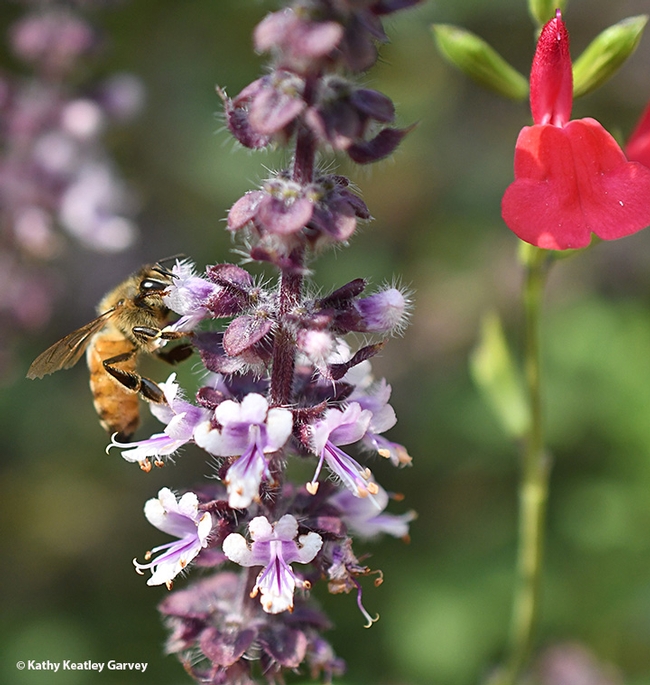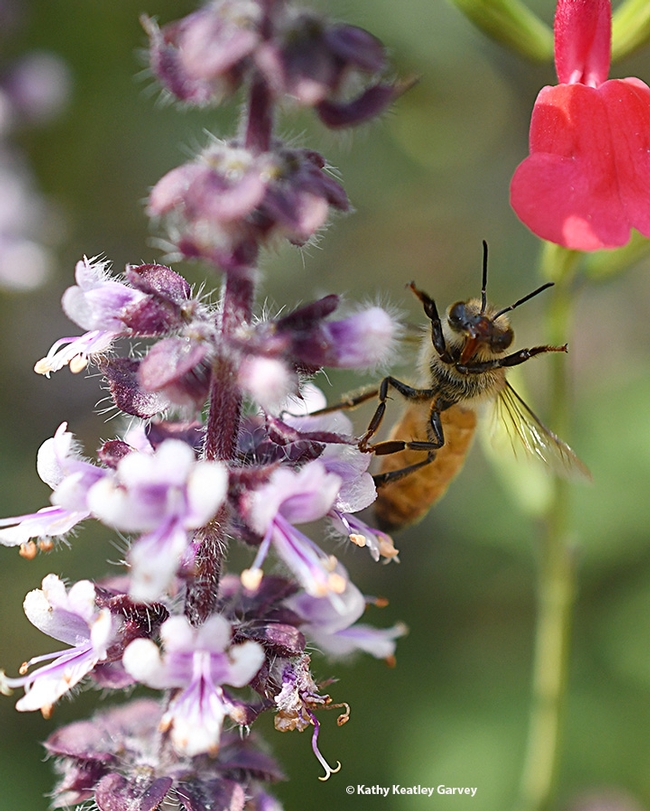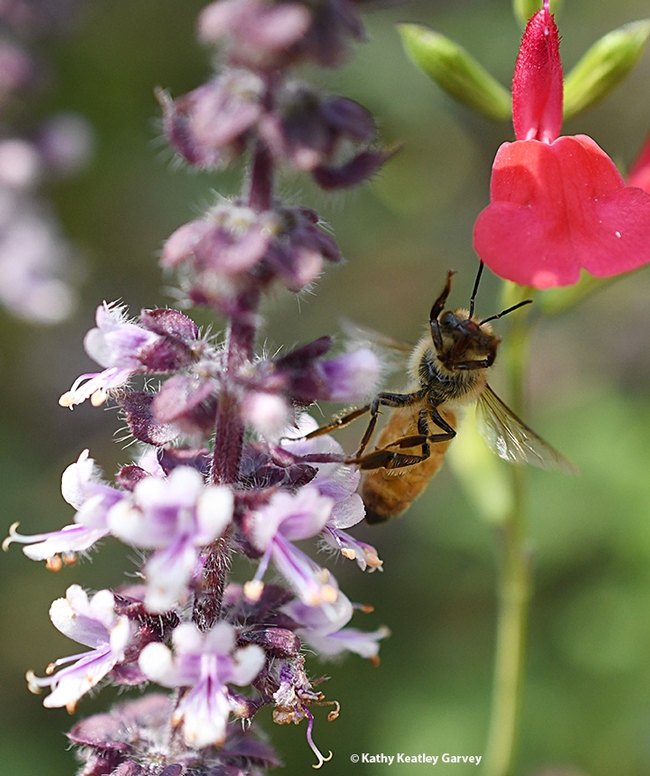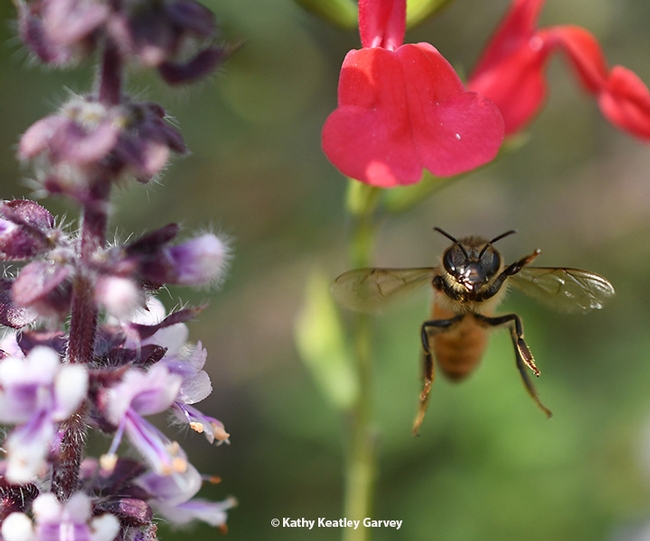Have you ever pulled up a chair in your garden and watched honey bees foraging?
They are so intent on their "bees-ness" that they don't know you're there. It's a great opportunity to photograph them.
Sometimes, if you're lucky, they'll buzz over your head on their way back to their colony, and you'll see:
- The three main body parts: head, thorax and abdomen
- The two pairs of wings
- The three pairs of legs
- The pair of antennae
Such was the case in Vacaville this week when we were watching honey bees forage in our African blue basil, a bee magnet that we plant annually. We first learned of African blue basil, (Ocimum kilimandscharicum × basilicum 'Dark Opal'), through Gordon Frankie, UC Berkeley professor and the late Robbin Thorp, distinguished emeritus professor of entomology at UC Davis. They co-authored the book, California Bees and Blooms: a Guide for Gardeners and Naturalists (Heyday Books) with Rollin Coville and Barbara Ertter, also affiliated with UC Berkeley.
Want to know more about honey bees? Be sure to read the newly published The Art of the Honey Bee; Shaping the Environment from Landscapes to Societies (Oxford University Press) by noted bee geneticist and biologist Robert E. Page Jr., who maintains strong ties to UC Davis and Arizona State University (ASU). Also learn about honey bee anatomy on ASU's web page, "Ask a Biologist."
Page, who holds a doctorate in entomology from UC Davis, is a former chair of the UC Davis Department of Entomology. In 2004, Arizona State University (ASU) recruited him for what would become a series of top-level administrative roles. He advanced from director of the School of Life Sciences to dean of Life Sciences; vice provost and dean of the College of Liberal Arts and Sciences; and university provost. Today he holds the titles of provost emeritus of ASU and Regents professor emeritus, as well as UC Davis department chair emeritus, professor emeritus, and UC Davis distinguished emeritus professor.
Tool Kit
Did you know a bee has a tool kit? Page lists the tool kit in his book, The Art of the Bee: a compass, an odometer and a path integrator.
'As 'central place foragers,' bees fly out from the nest site and explore the surrounding environment in search of food resources," writes Page, renowned for his research on honey bee behavior and population genetics, particularly the evolution of complex social behavior. "They return to the nest with the resources they collect. To do this, they need to be able to navigate out and find their way back. To aid them, they have a toolkit of navigation mechanisms."
One tool in their tool kit is their internal compass that depends on the location of the sun.
"As light from the sun passes through the atmosphere, it becomes polarized," Page writes. "The pattern of polarized light in the sky depends on the angle of the sun relative to where you are looking. Bees have special sensors in their eyes for detecting the polarized light patterns. On cloudy days, they can't see the sky; but they can still locate the sun using ultraviolet light detectors. Ultraviolet light penetrates cloud cover, allowing bees to use the location of the sun as a navigational marker. With heavy clouds, bees can get to and from a resource by relying solely on landmarks that they learn; otherwise, they stay home until the weather changes. However, as the earth turns, the sun is always changing location relative to the horizon, making it an unreliable marker unless you know the time of day, and bees do. They learn the movement of the sun across the sky and reference it to an internal clock. We know they have the clock because we can train them to forage at specific times of day. If you anesthetize a bee, you can stop her clock. When she awakens and takes a foraging trip to a learned foraging station, her flight path will be offset by the amount of time lost. In other words, she will misinterpret the direction based on the current location of the sun by the amount of time she was anesthetized."
"The odometer plus the ability to determine a flight vector (direction and distance) from a given landmark along a resource flight path, using their sun compass and internal clock, give bees the basic tools for navigation," Page writes. "The last tool in the toolkit is a path integrator that combines the compass and odometer information."
It's a fascinating book by Page, whose most salient contributions to science include constructing the first genomic map of the honey bee, which sparked a variety of pioneering contributions not only to insect biology but to genetics at large.
Meanwhile, take the challenge. Pull up a chair in your garden and watch and photograph the bees going about their "bees-ness."
Attached Images:

A honey bee nectaring on African blue basil in Vacaville, Calif. At right is Salvia microphylla "Hot Lips." (Photo by Kathy Keatley Garvey)

The honey bee, its tongue or proboscis still extended, departs from the African blue basil. (Photo by Kathy Keatley Garvey)

The honey bee pulls its proboscis back in and is leaving the African blue basil. (Photo by Kathy Keatley Garvey)

Frozen in time--a honey bee takes flight and heads for home. (Photo by Kathy Keatley Garvey)